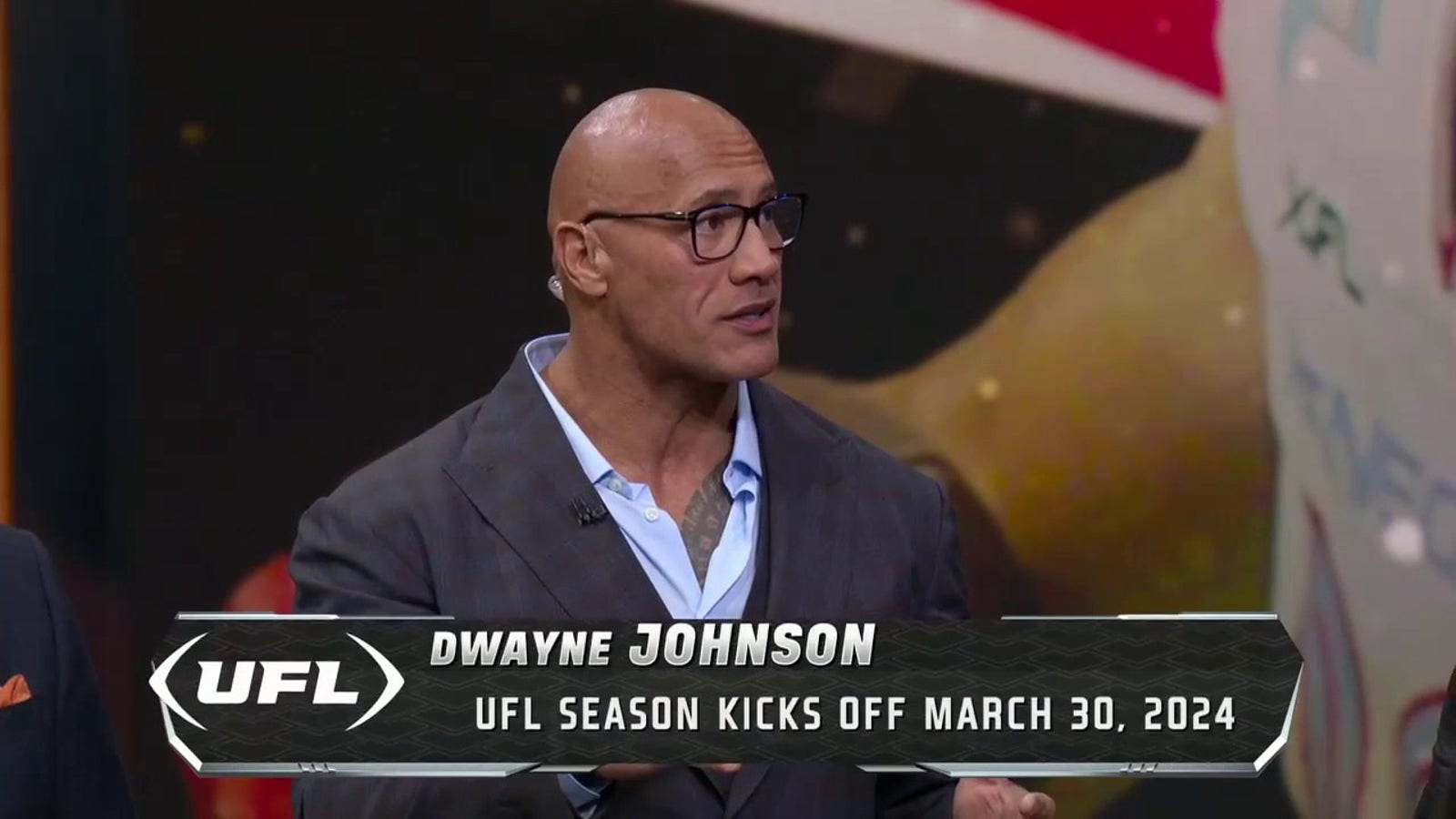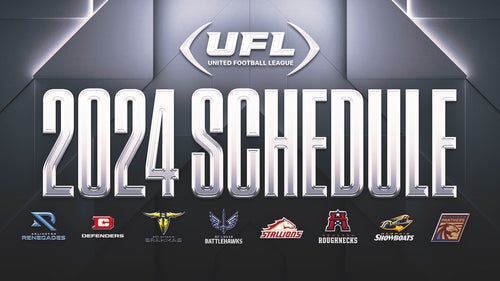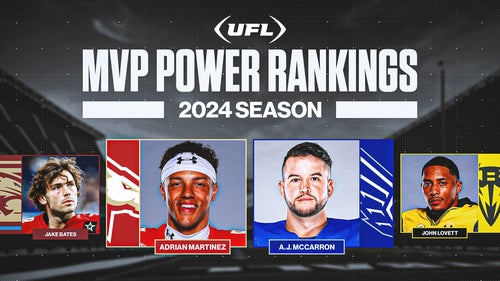
Daryl Johnston embracing new challenge as head of UFL football operations
For the past two seasons, Daryl Johnston, the former Pro Bowl fullback and FOX NFL analyst, has handled the day-to-day football operations for the USFL.
With the league now merging with the XFL to create the United Football League, Johnston will continue as the head of football operations for the UFL, the premier spring football league.
Former president and CEO of the XFL, Russ Brandon will serve as the president and CEO of the UFL.
As the UFL announced Monday, four teams from the USFL will remain in the Birmingham Stallions, Memphis Showboats, Michigan Panthers and Houston Gamblers (rebranded as the XFL’s Houston Roughnecks).
On the XFL side, the Arlington Renegades, D.C. Defenders, San Antonio Brahmas and St. Louis Battlehawks will stay on.
"We don’t have any egos, and that’s been fantastic," Johnston said about the merger. "There’s nobody that’s not in this for the right reasons.
"We are aligned at what’s best for the company, and that’s why we’re here. What are we doing this for? In that regard, there’s no deviation from the end goal, which is creating opportunities for these players to continue to chase that dream — not just get to the NFL but stay in the NFL. That’s where we change a young man’s life."
Johnston had a lengthy conversation with FOX Sports about the vision of the UFL in this wide-ranging interview that has been lightly edited for clarity:
What is your role, and how has it changed with the United Football League?
Johnston: It really hasn’t changed all that much. What has happened is one of the things that Russ Brandon and I talked about early in this whole process, was making sure as we contracted in Year 1 and then getting ready to expand back out as we move forward, that we didn’t lose the good people we had on both sides.
So, that was our primary goal going through this whole process of doing the merger — making sure that we didn’t lose anyone that was critical.
For my role, (FOX Sports CEO and Executive Producer) Eric Shanks was my boss back in the USFL days, and now Russ Brandon is the guy in that position, overseeing the CEO capacity of everything. He has his finger on the football side, has his finger on the business side. So, that really hasn’t changed all that much, but he has given me the authority to run football operations.
How does this merger grow and strengthen the prospects of spring football sticking around long term? And does creating innovation remain a priority?
Johnston: I think the big thing is — and we talked about this a lot in the USFL — crawl, walk, run. That’s going to be one of the things that I talk about a lot. Let’s make sure that we are doing everything in the correct and timely manner where we’re not getting ahead of ourselves.
We want to make sure that we crawl, then we walk and then we run. That’s the big thing when we talk about the pace. I think a lot of people, when they looked at us, said, "Well, you had two, eight-team leagues, and you’re back to a single, eight-team league. Why would you do that?" Well, it’s part of that crawl, walk and run.
We’ve got to come back together, re-establish and build that foundation back up again. Embrace the positives on both sides. And improve in the areas where we each struggled. So, that’s going to take time. And you don’t want to have something too large to be able to manage in that situation. So, that’s going to be a huge part there, kind of keeping that pace.
And the innovation. One of the great things that happened this past year is we worked with DV Sport, and when you talk about medical replay and sideline replay, together with Apple, we had mobile iPads on the sidelines. Once our players in the USFL had that, that’s one of those things that’s hard to move off, because you’re getting it in real time.
The communication with the coaches upstairs is not as critical, and that allows them to focus more on snap-to-snap and anticipate what’s coming — what is the offense or defense doing differently that we didn’t anticipate — because he doesn’t have to have the ordinary conversation of "Hey, what did you see in that last series?" Our guys have seen it already in real-time.
I would talk with our quarterbacks, and they would say we are so much further down the road as we get into that next week because I’ve already watched the game on the sideline. When I watch the game on Monday with the coaches, I’m watching it a second time. So, you’re really starting to take something that happened at game speed and push it to that next level of learning.
But there are a number of different ways that technology has come into both of our leagues and made an impact. And it’s kind of what spring football is about. It’s not about just the player, it’s about what else can we provide for the NFL or be kind of their testing grounds to put things in place to make this game better."
Speaking of the NFL, how important is it to build on the partnership with the league?
Johnston: I can’t tell you how many coaches came to me during our (NFL) broadcast season and said, "Hey, keep doing what you’re doing. We need you guys. We need that element. We don’t have the time and resources to develop players individually like we used to have."
And that’s one of the things I don’t think people get. Whether it’s bargained in the CBA or part of the player health and safety component, when we talk about time on task, that’s when you get better as players.
So, you’ve got positions like offensive line and quarterback that aren’t playing enough football and seeing it at game speed. … So, we’ve got all these guys in football operations that have great connections into the NFL and can really start to introduce those opportunities and create conversations of really what are complete end-game is.
And that’s the big thing, to really continue to just grow and build that partnership with the NFL. And I think the biggest thing this merger did is it accelerated that opportunity to have those conversations.
How are rosters constructed?
Johnston: One of the biggest things this year is we’re going to have a few things that are just for this year as we transition from 16 teams to eight.
The one thing that we wanted to make sure we did is we make the league as strong as we possibly can, which as you’re going through attrition, the one positive on the back side of that is our coaching staffs should be much stronger because we are condensing. And our rosters should be much stronger because we are condensing, if we do it the right way.
So, that’s the one positive coming out of this. The negative is we’ve got basically eight staffs and eight teams of rosters that aren’t going to make this transition with us. Hopefully, they take that as motivation, and they’re going to be back and prove to people that they deserve to be in this league, that they are good enough to be in this league, and we get another opportunity to visit with them next year.
But the big thing for us this year is making sure we step away from this thing as strong as we can possibly be. One of the big numbers that’s different is we’re going to take 75 players to training camp. Last year, the USFL took 58. I think the XFL took 66. So, you’re talking about nine players more for the XFL, but for the USFL, it’s 17 players more. And then you take that out and multiply that by the number of teams, and we’re creating more opportunities for a bunch of guys to get into training camp. …
Once we get to the regular season, we’re going to kind of transition to what we once were. We’re going to have 50 active roster spots total, and 42 active roster spots on game day. The 42 is an uptick from the USFL's 40 last year, and we’ll carry an emergency third quarterback as an inactive going into the games.
With the creation of XFL and USFL divisions, along with the meeting of the two 2023 champions of the two leagues to open the UFL, is there still a friendly rivalry between the two leagues?
Johnston: Yeah, absolutely. We’re all competitors, right? So yeah, there’s going to be a little bit of friendly competition, as long as it remains friendly (laughs). That’s one of the biggest things we’re all waiting for. As we’re unwinding all this transition right now, we’ve had to go down parallel tracks as two separate entities.
And even as we’ve had conversations and meetings to talk about the merger process, you still had to prepare as individual leagues. We are getting very close. We have our last event where we have to function like two separate entities. The XFL will do their dispersal draft with their four teams that didn’t make the merger, and the USFL will do their dispersal draft with the four teams that did not make our merger, and then after that, we can put everything behind us and start to come together as one. We’re still closing the door on some small, few items, but at the end of the week, we’ll be able to move beyond that.
One of the things the XFL seemed to do well is fan engagement. How do you continue to build on that?
Johnston: That’s an area where we can learn from the XFL model, and what they did from their engagement. Kind of going to that single-hub model we did in Year 1 but going out and playing in the home markets and continuing to engage with the home markets. I think one of the mistakes that we made last year in the USFL was we all kind of exhaled a little bit after Year 1. And we needed to continue to stay engaged in Birmingham. And we needed to stay engaged as quickly as we decided where we were going to go in those home markets and start to build those relationships.
I think one of the most frustrating things for us was in Year 2, we struggled to match the attendance at our Birmingham Stallions games that we had in Year 1. We left too much of a void. We always have to make them think about spring football. We can’t have them wondering if we’re going to come back.
And I know we’ve got certain cities out there that have had multiple spring football leagues come into their communities and not make it. And so there is a lot of trust that you have to re-establish. And that seemed to be one of the things that we took for granted. We knew we were coming back, but we hadn’t earned their trust yet for them to believe we were coming back. So, I think that was a big lesson we learned on our side in the USFL.
We’ve done a much better job this offseason, staying in touch with our markets that are going to be a part of the UFL. So, we have stayed engaged with Michigan. We have stayed engaged with Memphis. We have stayed engaged with Birmingham. And both of us have stayed engaged in the Houston area.
And then what were the XFL’s key components of success where they had the attendance they had? How do we recreate St. Louis? How do we recreate Washington? The beer snake — there were some really cool things that were done for fan engagement that just became unique things.
I think we all kind of look at what English Premier League soccer has done, and there’s a very unique element there with the fan engagement and passion for the fan base and the interaction. We all want to create that bond and connection, where the fans do really feel like they are part of the organization, and I think there’s a lot of really good pieces on both sides when we function as individuals that we are going to bring to the table. And I think we’re going to be much stronger in that area coming out because we have great ideas on both sides.
With what has happened in the NFL this year, how can the UFL continue to serve as a developmental place for NFL officials?
Johnston: It’s not just about the players. It’s about the referees. It’s about people in operations. It’s about coaches. We’re not just an opportunity for players, we’re an opportunity for football —anyone that wants to have a career in the game of football, we’re a great place for you to try and get that opportunity.
When we come back to the referee position specifically, we’re seeing all these key referees that we’ve seen in the NFL all these years, and they’re all exiting at the same time. We’re going to have a huge void in the NFL here with some senior officials that could all retire at the same time, and that’s going to leave a huge hole. How do we get ready for that? And thank goodness that both of our leagues were up and running in the last few years, because it did give them game reps.
And it’s just like the players — it moves super fast. And it’s going to test your communication. It’s going to test your mechanics. I think that’s one of the biggest things this season, is some of the key ones (in the NFL) is it’s not just a bad call, it was really some of the fundamental components of mechanics, conversation and communication. And that’s something that you wouldn’t think would happen.
So, I think the ability for us to get in and really the oversight that the USFL had with Mike Pereira, and the XFL had with Dean Blandino, and the ability for them to get in and fix it. And it’s coming from a single source, so how do we replicate that? "Boy they don’t have 32 teams down there, but this looks really positive, and they don’t have a lot of the big mistakes."
Eric D. Williams has reported on the NFL for more than a decade, covering the Los Angeles Rams for Sports Illustrated, the Los Angeles Chargers for ESPN and the Seattle Seahawks for the Tacoma News Tribune. Follow him on Twitter at @eric_d_williams.











































































































































